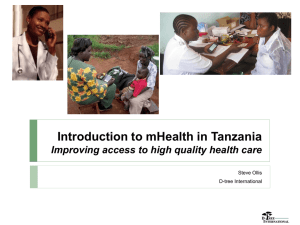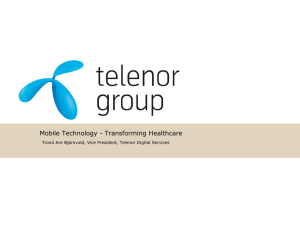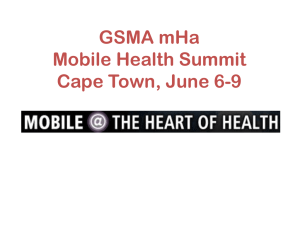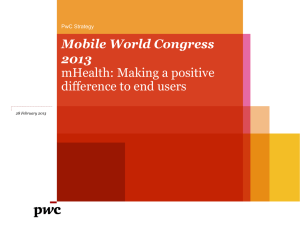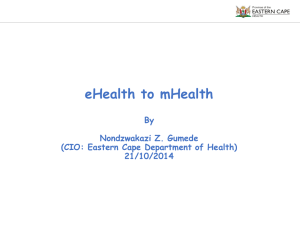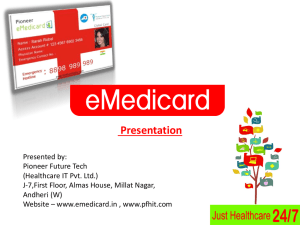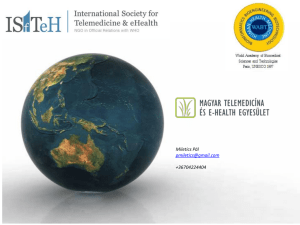Richard Cockle, Project Director mHealth, GSMA
advertisement
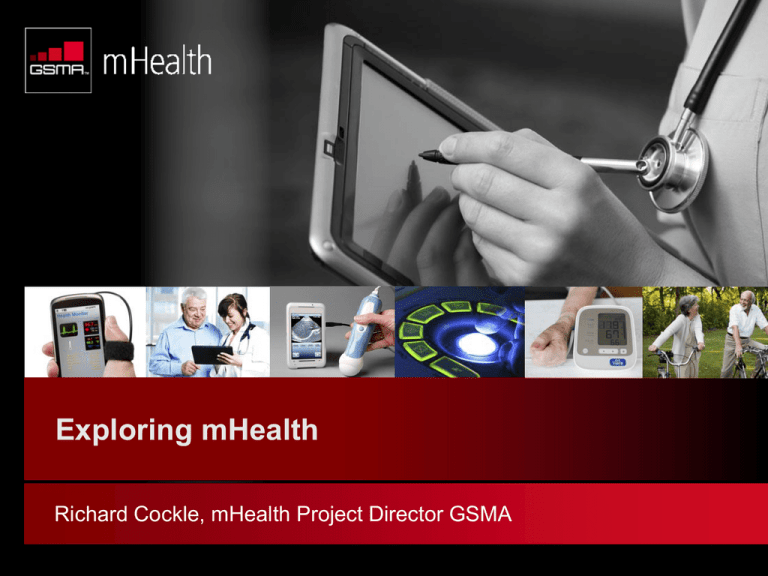
Exploring mHealth Richard Cockle, mHealth Project Director GSMA © GSM Association 2011 Introductions & Antitrust compliance All GSMA meetings are conducted in full compliance with the GSMA antitrust compliance policy, which applies during all events to all documents Do not enter into discussions about commercial terms (market/carrier/vendor prices, discounts, commissions, etc) and other business issues of your company Rule of thumb: do not exchange information in a meeting which you would normally consider a business secret The Antitrust compliance policy is available on the frontpage of the InfoCentre. For more information: dwalsh@gsm.org © GSM Association 2011 Agenda © GSM Association 2011 Item Speaker 09:30 GSMA Introduction - Update on the status of the work stream, 09:50 Ongoing mHealth work and research 10:30 Regional perspective on mHealth 10:50 Orange Healthcare Solutions Richard Cockle, Project Director mHealth, GSMA Trond-Are Bjørnvold, Vice President Telenor Next Robert Sinclair MD, PHD, Senior Medical Advisor Ian Hay, Head of Emerging Technologies, Orange 11:10 Coffee/Tea break 11:30 GSMA Diabetes Programme 11:50 Renewing Health 12:10 12:30 Brainstorm and Discussion Group discussion Richard Cockle, Project Director mHealth, GSMA Michael Strübin, Programme Manager, Continua Health Alliance All All 13:00 Wrap up GSMA 13:30 Lunch What is Mobile Health? Solutions across the Patient Pathway Prevention Diagnosis Treatment Monitoring Healthcare Systems Strengthening Emergency Response Healthcare Practitioner Support Healthcare Surveillance Healthcare Administration Source: Touching lives through mobile health, PwC February 2012 © GSMA 2012 Challenges facing healthcare delivery today? © GSMA 2012 Improve doctor to patient ratio More self management and self care results in less visits to the doctor Patient reach Remote monitoring solutions means access to healthcare for patients in less accessible areas Aging populations Adds pressure on healthcare systems and increases demand for new simplified solutions in healthcare Chronic diseases Increase in prevalence requires solutions in the areas of remote monitoring and self management by patients Mobile Health is Here – 800 deployments worldwide North America 168 Lat Am 76 Europe 119 Asia Pacific 180 Africa 257* Source: GSMA Mobile Health Services Deployment Tracker August 2012 *Including Middle East © GSM Association 2012 Global Mobile Health business opportunity Total Market Size: USD ~23 Billion Forecast global mHealth revenue (US$ Billion) Global mHealth revenue by region (US$ Billion) 23 Latin America, 1.6 , 7% 15.4 10.2 USA/Canada, 6.5 , 28% Africa, 1.2 , 5% 6.9 4.5 2013 Asia Pacific, 6.9 , 30% Europe, 6.9 , 30% 2014 2015 Source: GSMA/ PWC 2012 2016 2017 Source: PWC 2012 Monitoring represents 65% of global revenue opportunity © GSM Association 2012 The mobile health opportunity within the EU mHealth Service Type Monitoring Practioner Supt Other areas mHealth Market in EU in 2017 Diagnosis Treatment 5% 15% Germany $1.05b 16% 6% 8% Rest of EU $3.3b France – $0.8b 12% 48% 11% India $0.6b 65% Russia $0.8b 8% 6% UK $0.4b Italy 6% $0.55b Source: GSMA/PWC 2012 The rising number of chronic disease patients in countries like UK, Germany and France, along with their aging population are expected to drive the take up of monitoring services. © GSM Association 2012 $6.9b Due to the long term disease condition in EU, their will be a large opportunity on treatment compliance products and services within the EU region GSMA’s programme entering the 3rd year 2012/13 Market Acceleration 2011/12 Capabilities 2010/11 Foundation Framing the opportunities and challenges for Mobile Health Developing the capabilities and knowledge to be able to accelerate a scalable sustainable market (e.g. reference architecture, evidence guidelines, device regulation) Addressing the existing market barriers and pushing for market acceleration of Mobile Health, where mobile operators play a leading role in creating a scalable and interoperable market FOCUSING ON MARKET ACCELERATION © GSM Association 2012 GSMA mHealth Programme Aims Showcase mobile health solutions and catalyse cross-industry awareness and knowledge Demonstrate outcomes and impacts on individuals, healthcare systems and society Foster new relationships and partnering with the healthcare sector and mobile industry Stimulate scalable, replicable solutions to drive towards interoperability at critical junctions Promote supportive policy and regulatory principles for growth and innovation Mission: reduce cost to serve, extend reach and improve quality of care © GSM Association 2012 Connected Living: mHealth Objectives 2012/13 Mission To reduce the cost to serve, extend reach and improve quality of care to patients, by accelerating the development and adoption of scalable and interoperable operator led mobile health solutions Strategic Objectives 2012/13 Market Acceleration • Increase the number of operator led mobile health trials and service launches that generate clinically relevant evidence and demonstrate the use of operators assets beyond connectivity © GSMA 2012 Increase Market Pull Promote Operator Assets Stakeholders Buy-in • Stimulate the • Generate awareness by • Create a favourable demand side of healthcare industry and conducive mobile health and providers on environment for the ecosystems to drive benefits of operator acceleration of mobile the need for mobile assets to mobile health health solutions, by health solutions to solutions, creating the addressing key be introduced into way to more services decision makers the market beyond connectivity in (payers, governments mobile health and regulators) Market activation strategy Mission To reduce the cost to serve, extend reach and improve quality of care to patients, by accelerating the development and adoption of scalable and interoperable operator led mobile health solutions Chronic Disease Programme - Diabetes Over 346 million people worldwide have diabetes, it is forecast to double over the next 20 years. In some regions it already has prevalence levels 20 – 25%.The nature of the disease means that patients require regular monitoring, making it the perfect candidate for mobile health. Operators have identified diabetes as a key area of their strategy and are keen to collaborate to develop scalable solutions with sustainable business models. The aim is to create a Hero programme that can focuses the efforts of the programme, while the background work continues. Bringing operator together to focus on a common goal, including all types of tech SMS – EM Sensor. High level deliverables • Campaign Vision, scope, objectives; Diabetes summit to agree common approach; 10 operators sign up to running trials Regional Engagement Plans Every region is at a different stage of their understanding and uptake of mobile health. The key stakeholders are different so if the GSMA is to have an impact it will need to tailor its engagements to the specific requirements of the region. The regional plans will be made up of the deliverables contained with tis phase of the project and ongoing activities. Examples: US - End user research, Engagement: Direct with FDA, Continua US policy WG, Continua Tech WG Showcase at HIMSS, etc © GSM Association 2012 First half of 2012/13 © GSM Association 2012 Achievements in the last half year - highlights Technology/Architecture – Development of an landscaping paper – providing a summary of how NFC is been used in Healthcare – Demonstrators of UICC use in Healthcare – Orange – Card Vite, Dialog – USSD access to a medical health record. Strategy and Markets - Re-launch of GSMA mHealth tracker – Now over 800 deployments worldwide - Creation and launch to operators of the Diabetes campaign and detailed evidence analysis paper published. - Became a consortium member of the future EU eHealth programme United for health – ( 9 Clinical trial programme in 5 countries) © GSM Association 2012 Achievements in the last half year Regulation and Policy Develop of an EU medical device regulation paper Creation of an EU operator task force Promotion ‒ Showcase stand at WoHIT in Copenhagen (eHealth week) ‒ mHealth workshops held at Connected Living Summits in Korea and Brazil ‒ Mobile operator only round table held in Brazil ‒ Hosted a mHealth webinar – ‘Evidence generation for Mobile Health’ © GSM Association 2012 Plans for the rest of 2012/13 © GSM Association 2012 Milestones for the rest of 2012/13 Technology/Architecture – Promotion of mobile operator assets for use in mHealth solutions – Advocating of healthcare standards use on mobile device Strategy and Markets - Public launch of GSMA Diabetes campaign (WGs in Middle East, Asia, and Lat Am) - Creation of a showcase for mHealth in Catalonia - Stimulation and support of live mobile operator lead mHealth solutions Regulation and Policy - Develop of an EU position paper on medical data privacy and security - Participation in the EU DG SANGO mHealth working group - Social and economic benefits analysis of mHealth in the EU - Latin Am Medical Device Regulation Analysis © GSM Association 2012 Milestones for the rest of 2012/13 Promotion ‒ Showcase of global mHealth solutions at mHealth Summit Washington ‒ Showcase of mobile technology at Medica ‒ Publication of End User research (US, Brazil, China and India) ‒ Promotion of mHealth events at Mobile World Congress ‒ Connected living workshop showcasing the benefits with DG Connect © GSM Association 2012 Consideration for today In your opinion what is the key items that will drive adoption of mHealth within 2013? (Barriers or Opportunities) What is the biggest challenge facing your organisation to enable it to make a success of mHealth? What do you think the GSMA could do to support the realisation of the mHealth opportunity? © GSM Association 2012 Telenor :Ongoing mHealth work and research Trond-Are Bjørnvold © GSM Association 2012 What are the current issues? Healthcare and Mobile industries can offer better and value added services if collaboration between the two industries is achieved Fragmentation versus Interoperability – Current solutions are limited to “one solution, one device”. Scalability can be reached if systems are developed in a interoperable way Harmonised Regulation – Regulation on medical devices vary between countries and regions, it needs to be harmonised Understanding the End User of mHealth – The needs and requirements of end users need to be addressed to create a market pull for mHealth services © GSM Association 2012 For more information Events: Medtech Forum, Brussels 10-12 October Medica, Dusseldorf 14-17 November mHealth Summit, Washington 3-5 December Mobile World Congress, Barcelona 25-28 February 2013 © GSM Association 2012 Tools: Device Listing www.gsma.com/connectedliving/?p=6 27 mHealth Deployment Tracker www.mobilehealthlive.org/mhealthtracker/ Evidence Knowledge Bank www.gsma.com/connectedlivingmhealth-evidence-knowledge-bank/ Back up slides © GSM Association 2011
